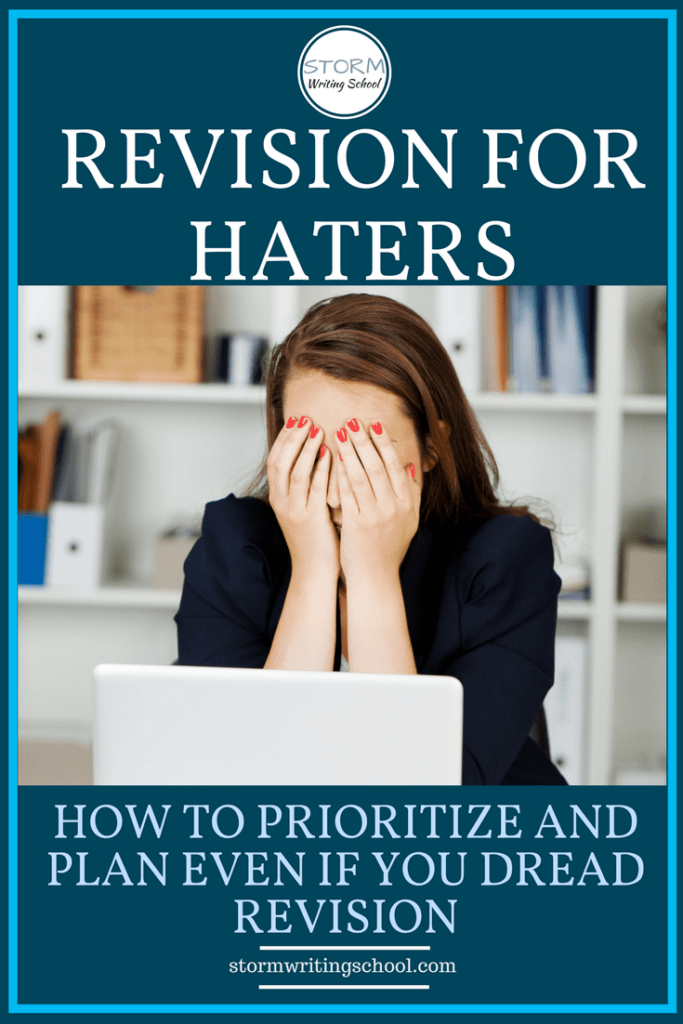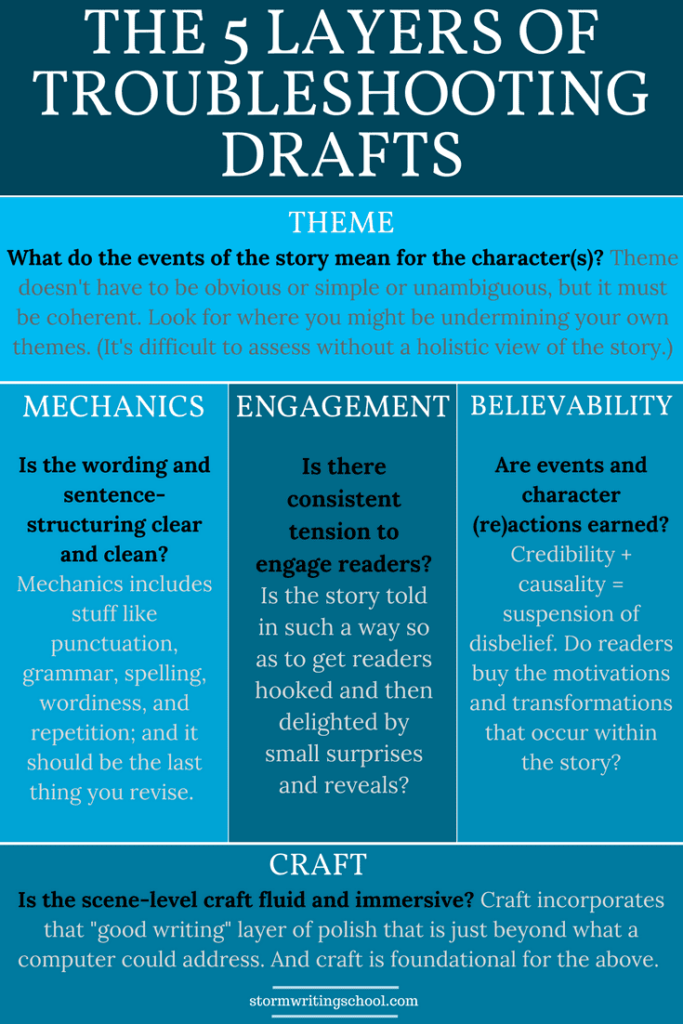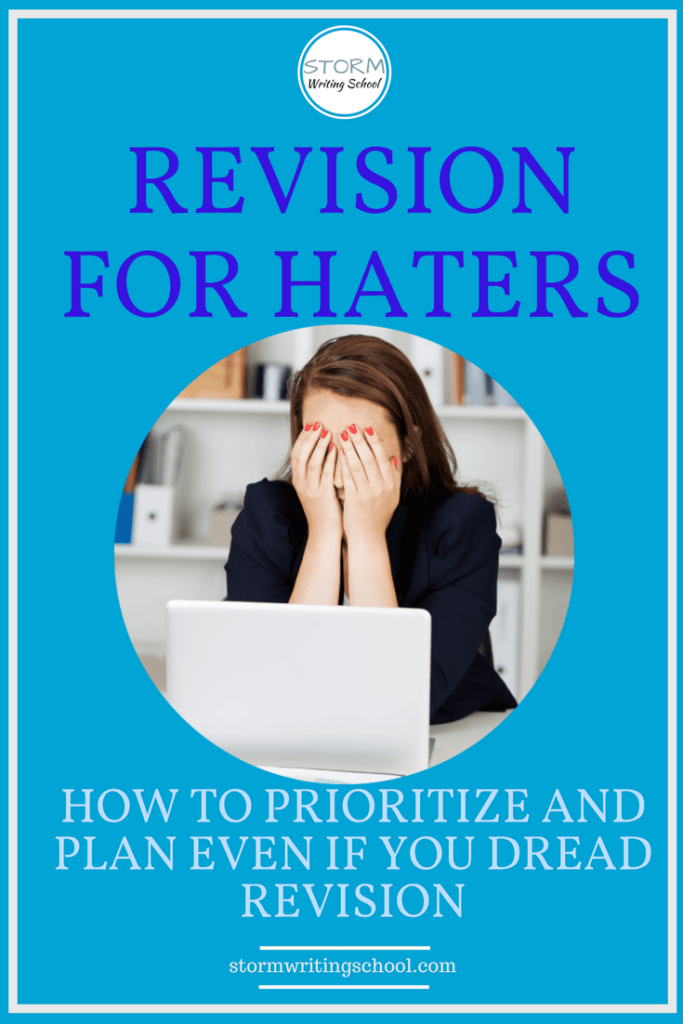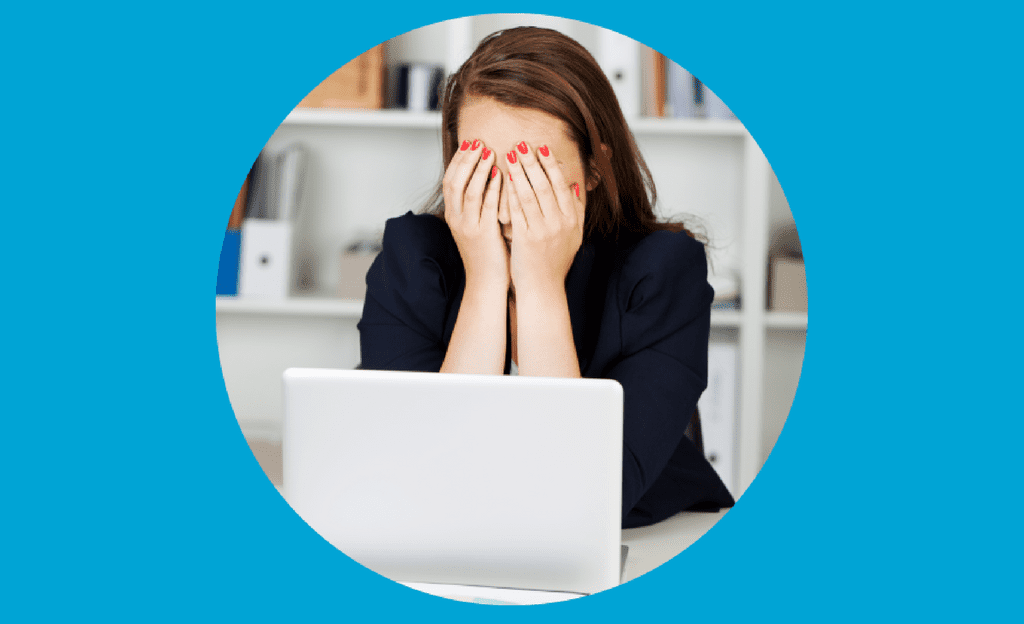I have a confession: I dread revision.
When I’m in the midst of drafting a story, I get a thrill from completing my modest daily word counts and surprising myself with my own genius. In fact, story creation is one of the only things in my life that is a perfect blend of work and play, of productivity and leisure. It’s such an ecstatic feeling for me that I regularly have quasi-lucid dreams in which I break away from the scene I’m dreaming—being chased by middle-school-aged zombies under some bleachers by a baseball diamond, for instance—and think, within the dream, “this would be a great story; I have to remember this!” I watch as the dream proceeds—plot twist: I am a zombie!—but then I wake and realize it’s not actually as amazing a plot twist as I thought it was.
Revision is like waking up.
And it sucks.
The trick, for me at least, is to hack my own brain in order to force myself to revise.

How do I bring myself to revise?
1. Believe in the necessity of revision
2. Plan
3. Know the challenges
a. Get quality critiques
b. Prioritize levels of revision
4. See it through
The necessity
I’ve been at this long enough to know that revision is the name of the game. No revision, no publication. No revision, lesser quality. I have some relatively good first drafts, but they’re not, as I often think while writing them, genius.
It comes down to a question of whether I believe in my stories, though. There are some drafts that I let die. I don’t revise them because I know my time and energy would be better spent drafting something else entirely.
But when I have something I believe in, I owe it to that piece to make it shine.
Plan
The most productive form of procrastination is the to-do list. Planning is what I do to kickstart my whole revision process. Once I’ve engaged in a bit of trouble-shooting, usually with the help of some readers or critique partners, then I make a list of the problems to tackle. It’s not actual revision. It’s not very hard. There’s nothing to dread about the to-do list. And it almost always gets my creativity primed.
Know the challenges
You can’t revise without knowing what to revise. And how do you know what to revise? One source is yourself: listen to your own instincts about what isn’t working. As Laurel Yourke says, “Wondering whether what you wrote is good enough? You already know the answer.” Which is to say, if you doubt it, it’s probably in need of some revision.
But some of you are the kind of people who doubt yourself under all circumstances. So you’ll just have to jump a little earlier to the other source of troubleshooting: good critical readers.
Language is social. And storytelling is even more so. If your story doesn’t resonate with readers, it’s not doing what it was meant to do. Everyone needs readers. Peruse the acknowledgements at the end of any modern novel, and you’ll see that dozens of people helped out.
Levels of troubleshooting
But even once you have readers, it’s worth keeping in perspective the different levels of critique/revision.
A quick aside here: critique and revision are two sides of a coin. An analogy: when I’m wiping off the counters in my kitchen, I first look for the crumbs and spills. (I sometimes have to angle my head just right to see the spills because our countertops are black, thereby enabling us to live more easily like slobs). But searching for a mess is different from cleaning it up. Revision is cleaning; critiquing is finding the dirt. Aside over.
Sometimes, you hear people distinguish between macro and micro revision. Or, as Laurel Yourke says in her book, Beyond the First Draft, deep revision vs. “thesaurus syndrome,” which is “altering individual words instead of revising deeply.”
I find it very helpful to know about these different levels or layers of revision, and I’d like to posit five layers rather than just two.
When I’m coming up with my plan about what to revise, I like to keep in mind these varying levels of deficiencies within my writing. They help me know how to receive critiques and how to prioritize my revision. I can then focus on re-energizing the revision process because I tackle first the things that require creativity.
Mechanics
This is the first layer of problems within a manuscript. It’s also the easiest to address. It’s the stuff that computer programs can pick out for you these days. Grammar, spelling, punctuation, passive voice, sentence structure, adverb use, meaningless repetition, wordiness, vague pronouns. The goal of revising these problems is to make the writing clean and clear—which is important. But this should be the last stuff you revise.
It’s the mark of poor critique partners and/or really good writing when the only comments you get are about whether it’s okay to write “alright” instead of “all right” and other such remarks. More advanced readers will comment on mechanics in your manuscript—don’t get me wrong—but they’re not going to grill you on these problems because they know it’s final revision stuff.
Craft
The next layer is what I refer to as craft, and it’s a layer of polish that’s just beyond what a computer can address because it’s less about sentences and more about scenes. Does the dialogue sound authentic? Do you reveal character through action and description? Do you give us a solid sense of place without being overly descriptive? Are you transitioning well? Are you doling out back story and interiority effectively? Does anything feel contrived and writerly?
Solid craft makes a piece of writing feel professional. It may still be unsatisfying or boring or frustrate you with plot holes, but mechanics + craft is what we typically refer to as “good writing.”
I should say, too, that craft is foundational for the three other layers to come, so when I edit writers who have lots of problems with craft, I find the bulk of my comments addressing craft issues. Good craft won’t guarantee engagement and emotional resonance, but it’s necessary at least for the latter.
Engagement
Let me emphasize this point, though: you can have good writing without having reader engagement. This is the third layer to troubleshoot, and it’s about whether there’s consistent tension. Is the writer using mystery, suspense, and dramatic irony to consistently hook the reader and provide the story with forward momentum?
When we label people as good storytellers, it has a lot to do with their mastery of story tension. Two people can tell the same story, but the good storyteller knows how to roll out the tale in such a way that we want to know more, that we’re delighted with the small surprises and reveals.
Believability
This layer is about whether the events and character reactions are earned.
I’m in a small writing group with four very capable writers. Whenever I read a piece in that writing group, I make small comments on mechanics and craft. I occasionally point out places where there could be more tension. But it’s this layer that I find myself commenting on most, and it’s this layer that others most closely scrutinize for me. Would he react that way? She seems to have changed her worldview. This surprise comes out of nowhere. 
One of the greatest challenges for storytelling in the written medium is getting readers not only to be engaged by the story but to buy into it, to believe it. Because only if they believe it will they be moved by it.
Once again, I’m going to cite Laurel Yourke, who says that credibility + causality = suspension of disbelief. To affect readers, we need to get them suspending their disbelief. That’s what this layer is about.
Theme
And then we come to the apex of storytelling: theme. If readers are not distracted by errors in mechanics or by amateur craft, if they are consistently engaged and buy into the story’s causality and credibility, then they may come away not just moved, but with an enlarged sense of meaning.
That all sounds very grandiose. And I’m aware, having taught high school English for 15 years, that people resist the very idea of theme and dismiss it as overanalysis. But let me ground it for writers in something very practical: theme is about what the events of the story mean for the characters within it.
I don’t mean that theme is a conscious lesson that the characters are aware of; often, it’s the case that only the readers are aware of what the story’s events mean for the characters. But they mean something nonetheless.
I never set out to write for theme. But in every story, the events will mean something for the characters. And as a writer, you have to wrap your head around such meaning or meanings sooner or later (usually later).
This final layer is the most difficult to address. And in fact, it’s almost impossible to address until you have a completed draft of the whole story.

Seeing it through
So, I have a story. I’ve taken it to my writing group or shared it with an insightful editor or critique partner. They’ve told me what isn’t quite working.
Now what?
1. Get started.
I go through my notes and their comments and I make a to-do list. While I’m making that to-do list, I focus almost entirely on Theme, Causality, and Engagement issues. I list the problems, and then I list what needs to be done to get to solutions.
It’s really hard to list solutions and not get excited about them. The joy of drafting returns to me then.
2. Schedule it.
But the harder the prospective revision, the more I tend to put it off. That’s when I find I actually need to put it on the calendar. I need to schedule it and make space for it to happen.
3. Deadline.
And then there’s the deadline. Would writers get anything done without deadlines? Set it for yourself and maintain it. Commit to taking your piece back to a critique group or partner by a certain day. Commit to submitting your work for publication by a certain day. Give the deadline importance and urgency. Be a little stressed out. That’s okay.
If you want to get this revision done, will it require a deadline? If yes, then, what do you need to do? Make and keep a deadline.
Best of luck with your revisions (it’s not about luck, though)! Happy writing!
Need an editor—someone to help you see the various troubles for you to shoot? I might be right for you. Want to work on your craft and your tension-building? I can coach you. Looking for lessons in causality or on being writerly? I’ve got you covered here. Poke around the school and let me know how I can help. Classes currently on offer: Creating Sexual Tension, The Tension Lab, Story Momentum Mastery.
And subscribe to the newsletter to be notified of new classes, new articles, links of the week, and special offers/gifts.

SaveSave
SaveSave
SaveSave
SaveSaveSaveSave
SaveSave
SaveSave
SaveSave
SaveSave
SaveSave
SaveSave
SaveSave
SaveSave






